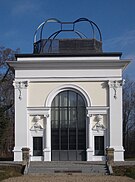Kees'scher Park
The Kees'sche Park is a historic park in the Saxon town of Markkleeberg south of Leipzig . It is named after the Kees family, from whom Erich Walter Jakob Kees owned and designed the park in the late 19th and early 20th centuries.
Location and shape
The Kees'sche Park is located on the western edge of Markkleeberg, in the district of Gautzsch , from whose former manor it emerged. The distance from its southern border to Lake Cospuden is 250 meters. The northern entrance is on Equipagenweg, the southern one on Pfarrgasse. The park's main path runs between the two.
The park covers an area of about ten hectares . Meadows alternate with picturesque groups of trees. A specialty is a blood beech avenue . A ring trench runs through the entire park near the outer border, but it is dry.
The Adlertor, the largest neo-baroque gate in Saxony outside of Dresden, has been preserved from the historical development, especially at the north entrance . It consists of the ten-meter-high column-adorned archway with two splendid wrought-iron gate wings, fighters and the gate crown, but without the eagle figure from which it was named. To the left and right of the archway are about ten meters long side wings with two large and one smaller wrought iron grilles.
Historically also restored the middle section of the Orangerie , often referred to as palm house, although this joined to the outer left Orangerie. The restored path system meets at the former well system, which also lacks water.
Somewhat hidden on the southern edge of the park is the as yet unrenovated, neo-baroque adorned entrance to the former approximately 100 m² large ice cellar. The arch bridge across from him led to the former manor house.
history
Already in the 13th century a manor of Ranvoldus de Kutez is mentioned in Gautzsch. In the 15th century there was a manor that remained in the possession of the Pflugk and Dieskau families until the 17th century . In 1713 it was bought by the Leipzig councilor, Chamber and Commerce Councilor Wolfgang Valentin Jöcher, who also owned a house on the Leipzig market . In addition to brisk construction activity in Gautzsch (church, mill, inn, farm building), he also had the manor house on the manor by the leading master builder of the Leipzig Baroque , David Schatz , increased and baroque, and a splendid garden laid out within a system of ditches around the property. After his death on March 5, 1728, Theodor Oertel von Döbitz acquired the property.
After several interim owners, it came into the possession of the Kees family in 1861, the descendants of the Saxon senior postmaster Johann Jakob Kees the Elder and the Younger. The neighboring Gut Zöbigker has belonged to the Kees family since 1714 . The family gave the Gautzsch estate to their offspring Erich Walter Jakob Kees (1864–1906) on his 21st birthday in 1885. He was less interested in agriculture than in technology, trade and art. He had the farm buildings located near the manor house moved outside the park and redesigned the park. This included an arched orangery over 100 meters long, to which a palm house was attached to the left. He installed water features, pergolas , terraces, bridges and avenues. The north exit of the park to the Equipagenweg he created was decorated with the eagle gate. The ice cellar got a lavishly decorated neo-baroque portal.
When Walter Kees died in 1906 at the age of forty-two, his widow and three children moved to Lake Como . The property, which had become too expensive for the heirs, was sold to the city of Leipzig in 1940, and Markkleeberg retained the right of use. In the meantime, military units were stationed in the manor house, which was designated as a hospital by the American occupiers after the Second World War , which it remained until 1992, disfigured by numerous extensions, conversions and additional buildings. The park deteriorated, and from 1993 the former hospital was subject to vandalism, including several fires.
At the beginning of 2000 the park was acquired by a private investor under the conditions of its restoration, the careful development only in historical locations with medical use as possible and public accessibility.
From 2004 to 2005, the park was renovated as a garden monument . The wild growth was taken and old lines of sight redesigned. The profile of the ring trench was restored after it was dredged, but it was left dry. Roads and paths were laid out again.
In 2006 the hospital ruins and other associated buildings were removed. The eagle gate, the central building of the orangery, the ice cellar with its ornamental portal and the system around the former fountain have been preserved.
In 2008 the Bärenherz children's hospice was built on the site of the former bird museum , the first in central Germany. It has 12 hospice places and also parents and siblings rooms.
In 2009, the renovation of the central orangery and the eagle gate began, which in 2010 was given back its almost four-ton wrought-iron gate. At the south entrance to the park, the gatehouse was used for catering by the "Brot und Kees" company.
literature
- Petra Mewes, Peter Benecken: Leipzig's Green - A Park and Garden Guide . Passage-Verlag, Leipzig 2013, ISBN 978-3-938543-49-8 , pp. 132/133 .
Web links
- Park website. Retrieved August 15, 2016 .
- Keesscher Park. In: Leipziger Neuseenland. Retrieved August 15, 2016 .
- KeeseBlatt No. 2. In: Website of the gastro-establishment Brot und Kees. Retrieved August 15, 2016 .
- Manor Gautzsch. In: State Archives Leipzig. Accessed September 1, 2020 . </
Individual evidence
- ^ Gautzsch in the Digital Historical Directory of Saxony
- ↑ Schlossarchiv.de
- ↑ picture of the ruin. In: Castle Catalog. Retrieved August 21, 2016 .
Coordinates: 51 ° 16 ′ 52 ″ N , 12 ° 21 ′ 24 ″ E








